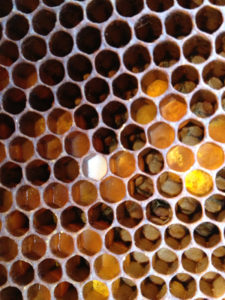Honey bees, like all social insects, are inherently aware of the late summer’s waning day length, low sun angle, and chilly nighttime temperatures. With the end of the sweet pepperbush nectar flow in mid-August the colony’s expansive mood of May and June has abruptly shifted — to conservation and consolidation.

It’s not surprising that our honey bees, originating in northern Europe, are genetically programed to prepare for winter, but, after many generations on this narrow and heavily forested peninsula, locally raised bees seem to know when the time of abundant nectar is definitely over. It must have been different in Thoreau’s 1850s Cape Cod, when the forest had been clear cut to an open heathland; now the native oak-pine forest is back and again covers nearly all of our undeveloped uplands.
This is great for our native ecosystem, but unfortunate for honey bees, because we don’t have the extensive bee pastures of fall goldenrods and asters of agricultural New England. If a colony hasn’t stored at least 50 pounds of honey by the end of August, the beekeeper has to subsidize its survival by feeding sugar syrup, an onerous task, or watch the bees starve by March.
September is the time for the bees to produce that last crop of offspring, the “winter bees,” who will carry the colony through the five or six months of flowerless winter. Along with sufficient fuel (honey) to keep the bee cluster warm through the winter, production of fat and healthy winter bees is crucial for colony buildup in early spring.
Winter bees are physiologically different and built to last. Whereas summer bees have little fat reserves and live just four to six weeks in the nectar-gathering fast lane, the abdomens of winter bees are (or should be) packed with “vitellogenin,” an egg-yolk precursor found in all sorts of egg-laying animals.
This is an amazing compound, functioning to protect wintering bees from infections and serving as a major protein reserve, along with comb-stored pollen, to feed that first big crop of spring bee larvae in March, well before spring flowers become abundant. Many colonies that are poorly nourished in late summer and fall may survive through early spring, but then either die or fail to grow to a sufficiently critical mass to produce a honey crop for the beekeeper.

Even colonies that are well nourished in fall and heavy with honey, pollen, and fat winter bees can be sabotaged by a tiny eight-legged invader. Back in the 1980s one could be fairly incompetent as a beekeeper and still have healthy colonies in spring. Not any more. Since then all Cape honey bee colonies have been infested with a parasitic mite, Varroa destructor.
Originally from Asia, varroa mites and the western European honey bee have not had enough time together to develop a stable host-parasite relationship that ensures mutual survival. As a consequence, these mites have been overwhelming and killing honey bee colonies all over North America. They feed on adults and larvae throughout the summer and, during the winter, clamp onto bee abdomens and gorge on their vitellogenin reserves. And if that weren’t enough, varroa mites transmit a long and growing list of disease-causing viruses.
Eventually honey bees and mites will learn to live together: the bees will develop resistance to the mites and/or the mites will become less virulent; it’s not smart for a parasite to wipe out its host. But this will take some time and, in the interim, it seems necessary for the beekeeper to somehow knock back the mite population well before winter — to ensure fat and happy winter bees, and live colonies come spring.
During the 1990s the mites quickly developed resistance to commonly used synthetic, and quite toxic, miticides. Now many beekeepers are having success controlling mites with naturally occurring organic acids, e.g., oxalic and formic, and extracts from hops and thyme.
Colony monitoring and mite treatments are a lot of work. But if neglected, colonies die and dying bees spread mites and bee viruses to hives throughout the neighborhood.
John Portnoy is an ecologist whose career with the Cape Cod National Seashore focused on the study of our local salt marsh ecosystems. He has been goofing with the bees for 30 years.
